Ignitable LNG Vapor Cloud
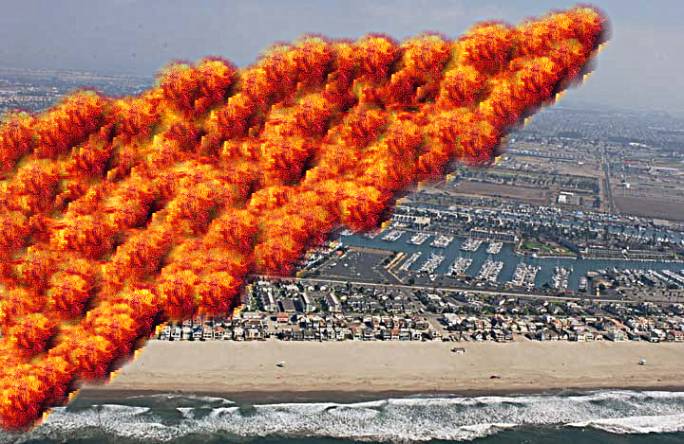
What is
Liquefied Natural Gas ?
It Is Natural Gas
Cooled to Minus 260 degrees
Condensed 600 Times
Into Huge Holding Tanks
Thus becoming…
Liquefied Natural Gas
¤LNG¤
LA
TIMES June 25, 2003
“When natural gas is to be transported over vast distances, it's chilled to a liquid state and shipped in vacuum containers — imagine big Thermos bottles — on oceangoing tankers.”
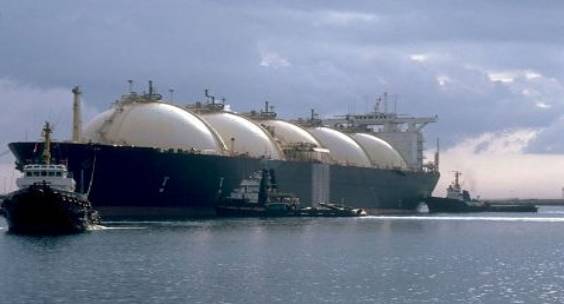
125,000 Cubic-Meters of LNG - Carrier Holds 20 Billion Gals. of Natural Gas
May 2009
Former CIA Official Warns Against LNG Terminal WJZ - Baltimore, MD, USA According to Charles Faddis, the retired head of CIA's Weapons of Mass Destruction Terrorism Unit, security is the safety issue. Faddis warns that an urban LNG operation creates two targets: the LNG plant itself and the enormous LNG tankers bringing in the frozen gas. According to the story, "the explosive power of a liquefied natural gas operation may be too good a target for terrorists to pass up."
July 2008
Samsung to Deliver World's Biggest LNG Tanker for Exxon Project Bloomberg Samsung was contracted to make 11 tankers, each of 266,000 cubic-meter capacity...
NOTE:
“The energy
content of a single standard LNG tanker
November 2007
ALERT: If you missed the NBC Channel 4 News, Los Angeles, Liquefied Natural Gas Special Investigative Report this past Monday, Nov. 26th, don't worry, it will be aired again on Sunday, Dec. 26, 9:30 pm. Also, it is available online: LNG Investigation - Videos - NBC
May 2, 2006
New Sandia Report of 7 Mile LNG Vapor Cloud Emediawire “This new Sandia 7 mile ‘worst case’ scenario is even more frightening than their earlier ‘worst case’ reported in December of 2004, which determined an offshore flammable LNG vapor cloud could extend approximately 2 miles,” said co-producer Tim Riley.
April 21, 2005
Text from US Congressional Record House Floor Arguments over Energy Bill H.R.6 Energy Policy Act of 2005 SEC. 320. LIQUEFACTION OR GASIFICATION NATURAL GAS TERMINALS at page H2344:
Mr. KENNEDY (D., RI)
“I will tell my colleagues, in Rhode Island we would welcome the chance to have our gas piped in from some other country because the fact of the matter is, our State knows, as every other State that has an LNG facility knows, that if we were to ever have that explode, it would decimate a 50-mile radius.
Mr. Markey (D., MA,)
“If you just want the Federal Government to decide in the middle of your district where this most attractive of all terrorist targets will be located, then you vote ``no,'' but understand the consequences on the floor today.”
FYI: Mr. Markey is also the Senior Member of House Homeland Security Committee
Does The U S Coast Guard
Consider LNG Dangerous ?
Currently, Savannah, Georgia
Has one of the four operational LNG importation facilities in the continental USA.
Below Is A Copy Of the Coast Guard Standing Orders
At The Savannah Port for Initial Action To Take
Upon LNG Discharge
STANDING
COAST GUARD ORDERS
SAVANNAH GEORGIA LNG EMERGENCY PROCEDURES:
"INITIAL
ACTIONS TO TAKE
IN THE EVENT OF A WORST-CASE DISCHARGE OF LNG
1.
Order the evacuation of all USCG personnel from affected area."

Why is LNG Vulnerable & Dangerous And Why
Would Our Brave Coast Guard Evacuate?
Liquefied Natural Gas
Is Not Flammable So long as It stays in its" Thermos Bottle"
But…Upon breach of its bottle It Rapidly Becomes An
Ignitable
Vapor Cloud
That Will Drift Downwind - On Shore Billowing and Spreading as it Becomes Ignitable
Once the Gas Dispersion Level Reaches [anywhere between 5% to 15% of Gas to Oxygen]
It Will Ignite From Any Source it Encounters Cell Phone, Cigarette Lighter, Attic Fan,
Light Switch, Auto or Boat Engine Spark Plug, Carpet Spark, etc…
Result…
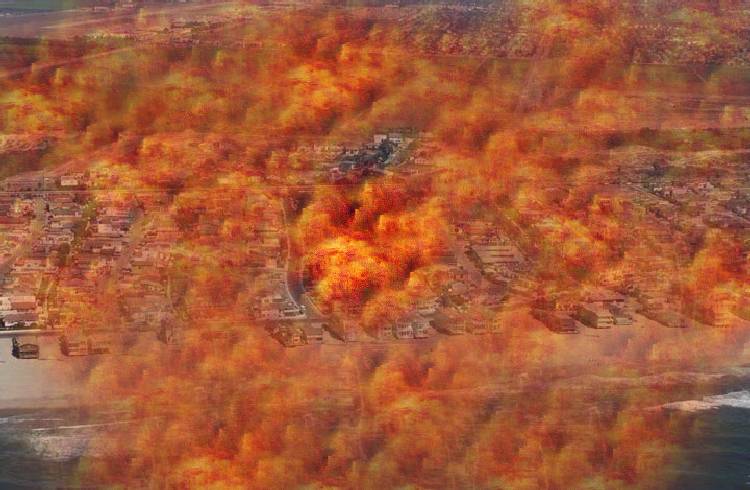
For
a Proposed LNG Facility
By SOCIO ECONOMICS SYSTEMS, Inc.

Calculated
Vapor Cloud/Population Risk Scenario
Based Upon An Off Shore LNG Carrier Collision in the Channel Traffic Lane
[125,000
Cubic meter Spill, Five Tank Rupture
Ignitable Vapor Cloud
Would Spread 30-Miles
Before
Ignition Blast
Population At Risk 70,000
[Based upon Projected Population For 1990]
Surprisingly, The 30-Mile Blast Estimate is Actually Conservative
When
Compared To The Other
Dispersion Models
Those Models Were Based Upon A Smaller Amount of Gas Release
[ Four Tank Rupture vs. Five Tank Rupture ]
Yet, Their Estimates Are Shocking
MIT
Prof. Fay…
Ignitable
Vapor Cloud Spread
127
mi
Bureau of
Mines…
Ignitable
Vapor Cloud Spread
76 mi
Coast
Guard …
Ignitable
Vapor Cloud Spread 26.2 mi
Energy Investor …
Ignitable Vapor Cloud
Spread
1.27 mi
This Horrifying Risk Has Been
Documented And Reported By The
California Energy Commission
LIQUEFIED NATURAL GAS IN CALIFORNIA: HISTORY, RISKS, AND SITING
STAFF WHITE PAPER, July, 2003
"The Oxnard City Council, however, did its own study, which considered safety risks under worst-case scenarios. Oxnard’s citizens opposed the project after the City’s study showed up to 70,000 casualties from an LNG accident there. None of the risk assessments considered acts of sabotage."
***
Based Upon the Conservative EIR 30-Mile Dispersion Model
A Fiery Inferno Would Engulf Everything For 30-Miles
Incinerating Communities Ranging From
Santa Barbara, Montecito, Carpenteria, Ventura, Oxnard, Camarillo, Port Hueneme, Point Mugu, Malibu, and Santa Monica

Which Community is Devastated
Will Depend Upon Where the Breach Occurs and
Which Direction the Wind is Blowing
Based Upon the EIR 30-Mile Dispersion Model
Possible Scenarios if Breach Occurred at the Proposed LNG Facility
At Platform Grace Situated Approx. 10.5 miles off shore of Oxnard & Ventura near Santa Barbara
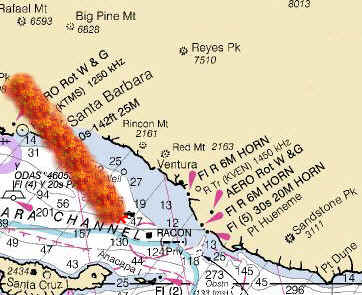
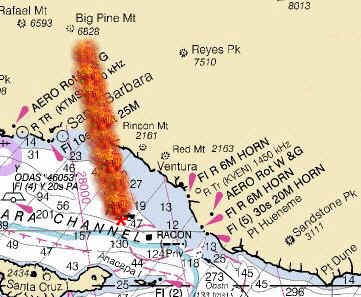

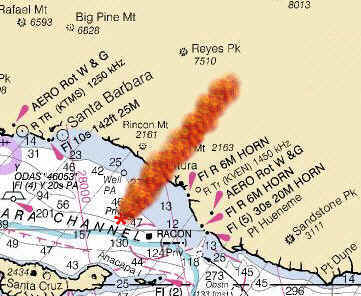
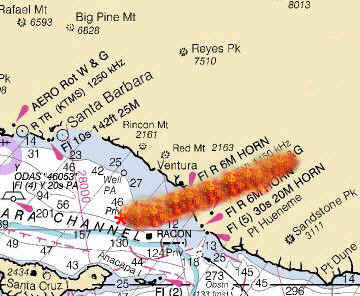
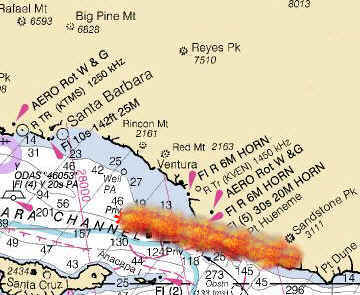
A Second Proposal Seeks To Place
A Floating LNG Importation Storage Facility Near Malibu
The Malibu Times,
September 11th, 2003
"The terminal would be located 14 miles offshore from Arroyo Sequit, near Malibu. Safety hazards and risks concern locals."
Based Upon the EIR 30-Mile Dispersion Model
Possible Scenarios if Breach Occurred to Just the LNG Tanker Docked at the Proposed LNG
Facility "Cabrillo Port" to be Situated Approx. 14 miles off shore of Malibu

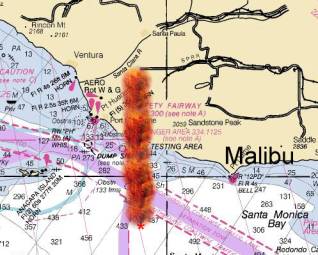
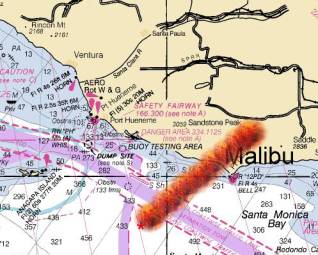
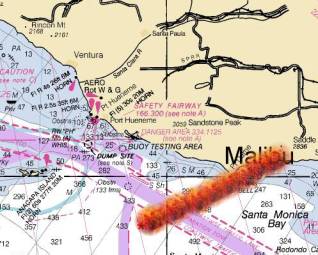
REMEMBER:
The graphic models above are based upon the breach of only an LNG Tanker 33 Million gals of LNG
The "Cabrillo Port" Storage facility itself would hold more than 2 LNG Tankers 72 Million gals of LNG
Accordingly, if full breach occurred to the FACILITY storage tanks holding
72 Million gals of LNG
[42 Billion gals of Natural Gas]
The Estimated Blast Zone
Would Far Exceed The Above Models
***
The Malibu Times
http://www.malibutimes.com/articles/2003/09/10/news/news1.txt
September 11th, 2003
"Tim Riley, a consumer protection advocate and personal injury lawyer from Oxnard,
stated in an Aug. 24 column for the Ventura County Star, 'LNG facilities, tankers and pipelines are vulnerable to major industrial accidents, earthquakes and terrorism, and they would pose realistic danger to our community. Tankers are approximately 950 feet long ... they hold 20 billion gallons of natural gas. Release of that enormous volume of gas would provide devastating power for mass destruction.'"
"Malibu resident Hans Laetz, who learned of the proposed Cabrillo facility after reading a business story in the New York Times, said in a phone interview, 'I personally think that, in all honesty, this is the biggest threat to the safety of Malibu residents since the DWP wanted to build a nuclear power plant in Latigo Canyon.'"
October 26, 2004
The Mercury News
Capps Warns of Earthquake Risk Near Proposed Gas Facilities
http://www.mercurynews.com/mld/mercurynews/news/local/states/california/the_valley/10020737.htm
VENTURA, Calif. (AP) - U.S. Rep. Lois Capps, D-Santa Barbara, wants federal officials to examine the possible earthquake hazards near proposed liquefied natural gas facilities off the Ventura County coast.
Capps sent letters Monday to the Federal Energy Regulatory Commission, the Coast Guard, the Department of Energy and the Department of Transportation asking for an evaluation of seismic activity in the Santa Barbara Channel before approving LNG facilities.
BHP Billiton and Crystal Energy want to build offshore terminals to convert the liquid back into a gas and send it to onshore Southern California Gas Co. buildings through pipes on the ocean floor.
BHP Billiton's site, called Cabrillo Port, would be 14 miles offshore, while Crystal Energy hopes to use Platform Grace, an unused oil platform 12 miles off Oxnard.
At Capps' request, the U.S. Geological Survey determined earthquake faults in the area could produce earthquakes up to magnitude-7.5.
"Earthquakes of this magnitude are capable of producing strong shaking, liquefaction, landslides, turbidity currents and tsunamis," Capps wrote. "In fact, the report reveals that in parts of the project area, the estimated shaking hazard is as high as along the San Andreas Fault."
A large earthquake in the area of the proposed projects "could create a 'pool fire' or ignitable 'vapor cloud' that is extremely dangerous, threatening life and property in all directions from the facility," Capps wrote.
PRNewswire
http://www.prnewswire.com/cgi-bin/stories.pl?ACCT=109&STORY=/www/story/11-01-2004/0002348884&EDATE=
November 5, 2004
Ventura County Star
Environmental report says danger from proposed natural gas port low
Full Story: http://www.venturacountystar.com/vcs/ox/article/0,1375,VCS_238_3307247,00.html
By Sylvia Moore
Abstracts:
The chances of a major accident at a proposed liquefied natural gas port off Oxnard's coast are very low, according to an environmental report released this week by three state and federal agencies.
The energy companies say their facilities would provide California and the United States with a much-needed supply of natural gas in the face of higher energy prices. Critics, including many Oxnard community activists, fear the facilities pose too many potential safety hazards and should not be built near populated areas.
Oxnard Mayor Manuel Lopez, who has publicly opposed the projects, said he and other city officials will soon examine the environmental report. Oxnard does not have veto power over the project but can let the state know what the city thinks.
"We'll have our staff go over it," Lopez said. "It is very critical to us in the coastal area. We're really going to have to scrutinize it."
Oxnard lawyer Tim Riley, an outspoken critic of the proposals, said Thursday that the BHP project should be shelved.
The report "provides no surprises on its way to fast-track approval of the ultra-hazardous, guinea-pig LNG project," Riley said in a statement. "We all must impress upon Gov. Schwarzenegger to timely veto both the BHP and Crystal LNG projects, which he has the legal authority to do.
"He can protect us and our multibillion dollar tourism industry, or he can permit the industrialization of our precious coastline and beaches as billions of American dollars get exported to Australia. The governor must decide what he wants his legacy to be."
Copyright 2004, Ventura County Star. All Rights Reserved.
LA TIMES
November 6, 2004
LNG Port Isn't Peril to Land, Report Says
By Steve Chawkins Times Staff Writer
http://www.latimes.com/news/local/la-me-lng6nov06,1,4383990.story?coll=la-headlines-california
Despite fears in coastal communities, a liquefied natural gas terminal proposed in the Santa Barbara Channel would do no harm on shore if it were destroyed in an accident or an act of terrorism, according to an environmental report released Friday.
The 1,200-page draft environmental impact report should reassure local residents, said a spokeswoman for BHP Billiton, the Australian minerals company proposing the massive project.
However, a number of environmental activists suggested the report was tailored to ensure the project's ultimate approval by Gov. Arnold Schwarzenegger. While reserving judgment on safety issues, an attorney for the Environmental Defense Center criticized the $1.5-million effort for failing to thoroughly investigate whether imported LNG is needed in the first place.
The proposed terminal would be at sea 14 miles from the border of Ventura and Los Angeles counties. Tankers from Australia would unload the super-chilled liquid fuel at the terminal, where it would be reconverted into a vapor and pumped through an undersea pipeline into a web of natural-gas lines that already crisscross the state.
Known as Cabrillo Port, the BHP project is one of two liquefied natural gas projects in the Santa Barbara Channel vying for state and federal approval. The other, developed by Crystal Energy of Houston, would turn a dormant oil platform 11 miles offshore into an LNG terminal.
Supporters argue that the projects are safe, technologically advanced methods of bringing a much-needed resource to California. The environmental report only confirms that point of view, said BHP spokeswoman Kathi Hann.
The report concluded that even in the worst circumstances, an ignited vapor cloud would span an area of 1.6 miles around the terminal, less than company scientists had assumed, Hann said. The chance of that occurring would be less than one in 1 million, the report said.
The project's critics, however, point to a 1977 Oxnard study that forecast an LNG accident producing a 30-mile-wide blanket of flame.
"I don't know what's happened in the interim to change that," said Oxnard Mayor Manuel Lopez. "The laws of physics haven't changed."
Skeptical about the environmental report, Lopez described it as "a whitewash." The city councils in Oxnard and Malibu have voted to oppose both offshore projects. The agencies with direct authority over them are the Coast Guard and the State Lands Commission, which hired the San Francisco consulting firm Ecology and Environment Inc. to prepare the report.
The proposals are to reach Schwarzenegger's desk next spring.
Spokesmen for environmental groups said the report failed to address some crucial issues.
"We're very disappointed," said Linda Krop, chief counsel for the Santa Barbara-based Environmental Defense Center, arguing that the report did not consider the possibilities of increased conservation and additional reliance on renewable energy sources.
She recalled the urgency expressed by developers who wanted to build a California LNG facility in the wake of the gas shortages of the 1970s.
"By the time the studies were done, it was determined we didn't need one," Krop said. "This feels like déjà vu."
In addition to weighing the risks of an accident, the report evaluated the project's potential effects on fishing, recreation and shipping. It said BHP's collaboration with the Navy reduced the risk of errant missiles from the testing range at nearby Point Mugu.
While seismic faults lace the region, sophisticated engineering techniques should keep the terminal and its pipelines safe, the report concluded.
Noise from the terminal would be "noticeable" more than three miles away, but it could be muted with advanced equipment, the report said. It also recommended that construction be timed to not disturb migrating whales.
Several public meetings have been set to allow public comment on the draft environmental report, which can be read at http://www.cabrilloport.ene.com .
They are at Santa Clarita City Hall on Nov. 29 at 7 p.m.; at the Oxnard Performing Arts Center on Nov. 30 at 1 and 6:30 p.m.; and at Malibu's Webster Elementary School on Dec. 1 at 7 p.m.
Copyright 2004 Los Angeles Times
Governor Schwarzenegger’s Legal Authority to Disapprove the LNG Deepwater Ports
TITLE 33 > CHAPTER 29 > § 1508
§ 1508. Adjacent coastal States Release date: 2003-05-29 (a) Designation; direct pipeline connections; mileage; risk of damage to coastal environment, time for designation (1) The Secretary, in issuing notice of application pursuant to section 1504 (c) of this title, shall designate as an “adjacent coastal State” any coastal State which (A) would be directly connected by pipeline to a deepwater port as proposed in an application, or (B) would be located within 15 miles of any such proposed deepwater port. (2) The Secretary shall, upon request of a State, and after having received the recommendations of the Administrator of the National Oceanic and Atmospheric Administration, designate such State as an “adjacent coastal State” if he determines that there is a risk of damage to the coastal environment of such State equal to or greater than the risk posed to a State directly connected by pipeline to the proposed deepwater port. This paragraph shall apply only with respect to requests made by a State not later than the 14th day after the date of publication of notice of an application for a proposed deepwater port in the Federal Register in accordance with section 1504 (c) of this title. The Secretary shall make the designation required by this paragraph not later than the 45th day after the date he receives such a request from a State.
(b) Applications; submittal to Governors for approval or disapproval; consistency of Federal licenses and State programs; views of other interested States (1) Not later than 10 days after the designation of adjacent coastal States pursuant to this chapter, the Secretary shall transmit a complete copy of the application to the Governor of each adjacent coastal State. The Secretary shall not issue a license without the approval of the Governor of each adjacent coastal State. If the Governor fails to transmit his approval or disapproval to the Secretary not later than 45 days after the last public hearing on applications for a particular application area, such approval shall be conclusively presumed. If the Governor notifies the Secretary that an application, which would otherwise be approved pursuant to this paragraph, is inconsistent with State programs relating to environmental protection, land and water use, and coastal zone management, the Secretary shall condition the license granted so as to make it consistent with such State programs. (2) Any other interested State shall have the opportunity to make its views known to, and shall be given full consideration by, the Secretary regarding the location, construction, and operation of a deepwater port.
Governor Schwarzenegger Must Decide What He Wants His Legacy to Be
The report "provides no surprises on its way to fast-track approval of the ultra-hazardous, guinea-pig LNG project," Riley said in a statement.
"We all must impress upon Gov. Schwarzenegger to timely veto both the BHP and Crystal LNG projects, which he has the legal authority to do.
"He can protect us and our multibillion dollar tourism industry, or he can permit the industrialization of our precious coastline and beaches as billions of American dollars get exported to Australia. The governor must decide what he wants his legacy to be."
Email Governor Arnold Schwarzenegger: governor@governor.ca.gov
Email the Governor's Resources and EPA Chiefs:
Mike Chrisman: mike.chrisman@resources.gov
Terry Tamminen: tt@CalEPA.ca.gov
Emphasize that the Governor must timely disapprove BHP and Crystal Energy's LNG Deep Water Port Licenses
November 10, 2004
Malibu Times
New gas port risk study doesn't appease residents
http://www.malibutimes.com/articles/2004/11/10/news/news6.txt
By Susan Reines/Special to The Malibu Times
A new environmental study says an explosion on a proposed floating natural gas port off the coast would not reach land, but residents question why the results are so different from an older study that concluded a 30-mile cloud of flame could reach the coast.
By Susan Reines/Special to The Malibu Times
A draft environmental impact study released Friday said an explosion on a proposed liquefied natural gas port off the coast would not affect Malibu, contrasting a 25-year-old study that said a gas explosion could cover the coast in a stretch of flames longer than Malibu's shoreline.
Representatives of the California State Lands Commission say the risk analyses are different because the 1977 study was conducted for an on-land gas plant, while the new environmental impact statement/report concerns a port, proposed by BHP Billiton of Australia, that would float 14 miles off the coast at the Los Angeles-Ventura County line, which is about 15 miles up the coast from Malibu.
"What we did was we evaluated an absolute worst case scenario, which would be the loss of all three LNG [liquefied natural gas] tanks on the port," Cy Oggins of the California State Lands Commission said. "We calculated 1.6 miles as the maximum radius for public safety impacts ... I think people who cite the 30-mile wall of fire claim that physics haven't changed, and of course we claim the same thing-physics haven't changed-we're just using a methodology specific to this project."
However, residents said the risk is unclear, and they are still uncomfortable with the proposed Cabrillo Port receiving chilled natural gas so close to home.
Mayor Pro Tem Andy Stern said the new study did not temper his resistance to the two proposed natural gas ports in nearby waters, the Cabrillo Port and the Crystal Energy Plant, for which an EIR has not yet been conducted. "That EIR does zero for me," Stern said of the new Cabrillo Port study. "I feel no better about it. What would do something for me would be not to build it."
Stern said the only real way to mitigate disaster would be to stop the project altogether. "I think it's outrageous that they're trying this new technology that, to my knowledge, has never been proven," he said. "And I understand this EIR comes out and says well, it's not a problem, but if it blows up, the people who wrote the EIR are going to be long gone. I don't understand why they would take that risk, except for profit."
The City Council approved a resolution strongly opposing both the Cabrillo Port and the Crystal Energy Plant in May 2004, and Stern said he didn't know why the city wouldn't consider joining with other cities to file a lawsuit or lobby the state government.
City Attorney Christi Hogin said the city has no authority as a government body to stop the project, though it could lobby against it like any concerned individual or group.
"I think the city's role is primarily like any interested party, giving its input," she said. "We don't have any authority."
Oggins said the draft report was written by independent third party consultants, but some in Malibu question whether business interests might have had influence.
"I think it appears to show an inclination to approve it," local activist Anne Hoffman said. "I mean, if developers got this kind of green flag to just say that there would be a very low chance of a major accident, that just conflicts with the expert and the public testimony."
Hoffman noted, though, that she had not had time to study the lengthy report in depth.
" I'm still processing it," she said. "It's a 1,200 page report, so I'm not giving you the final word."
The Cabrillo Port would receive natural gas from Australian tankers that carry the fuel in compressed liquid form. The gas would be vaporized and pumped through a network of pipes.
While the report does say new technology would be used to mitigate spills and explosions, it classifies the "potential release of LNG due to high energy marine collision or intentional attack" as Class I -the most severe -even after mitigation.
Governor Arnold Schwarzenegger has expressed support for LNG projects, saying natural gas could feed California's energy needs and help wean the state from oil and coal. Environmental groups have split, some emphasizing that natural gas is cleaner burning than coal and oil, but others saying the risks of spills and explosions are too severe.
Craig Shuman, staff scientist at local environmental nonprofit Heal the Bay, said the organization had not yet taken a stand on the new study because he had not finished reviewing it.
"If, when I review it, I see something that they need to be doing differently, we'll submit comments on the draft EIR," Shuman said, noting that project proponents have a legal obligation to respond to comments in the final EIR.
"When it comes to projects, that's where Heal the Bay is very effective, in that we'll write very strong comment letters and then the promoters of the project will have to go back and change their project," Shuman said.
Published On Line, November 24, 2004
Malibu Times
Local group opposes LNG proposal
http://www.malibutimes.com/articles/2004/11/03/news/news_briefs/newsbriefs.txt
A new local political organization has formed to oppose a liquefied natural gas facility proposed to be built off the coast of California near Malibu. Called Citizens Against Crystal Energy, or CASE, the group says it is trying to inform people about Crystal Energy's recent signing of a long-term lease for a local oil platform and its plan to retrofit it into an LNG facility.
"I understand we need to find a way to meet the growing need for energy in our country, but the proposal is just dead wrong," said CASE member Anne Hoffman, who usually devotes her political activity to property rights.
CASE says that the facility is old, highly unstable and prone to possible terrorism.
Another company, BHP Billiton, early proposed building an LNG facility off the coast of Oxnard. That sparked outrage throughout the area, with many saying such a facility presented enormous health risks. The Malibu City Council issued a resolution against the proposal.
Hoffman said she did not decide to become active in that LNG fight because there was already so much opposition. But in this scenario, she said there is not as much opposition because there is not as much knowledge.
"This one is moving along at a much faster pace and we need to galvanize the people who might not be aware of it," Hoffman said.
Mayor Pro Tem Andy Stern has also vocally opposed Crystal Energy's proposed facility.
May 25, 2005
LNG Breaking News www.TimRileyLaw.com
Re: BHP Cabrillo Port Application Docket # USCG-2004-16877
The following Formal Comments were submitted today to the DOT Docket Management System by Tim Riley
______________________________________________________________________________________________________
May 25, 2005
Comments by Attorney Tim Riley
Co-Host of www.TimRileyLaw.com and www.LNGdanger.com
Co-Producer of the film: The Risks and Danger of LNG
According to the National Nine News - NineMSN of
Australia on May 25, 2005,"Resources giant BHP Billiton is facing four charges over a fatal gas explosion at its Boodarie iron plant in
Western Australia's north.""WA's Department of Industry and Resources (DoIR) said it had charged BHP Billiton Direct Reduced Iron under sections 9(1) and 9(8) of the Mines Safety and Inspection Act 1994."
"The charges follow the department's assessment of a report ordered into the Boodarie HBI operations by the State Mining Engineer and DoIR's own investigation of the incident."
"The case will be heard in Perth Magistrates Court."
These are very serious charges, and cast doubt over the applicant's ability to protect human life from gas explosion and conform with required governmental safety regulations.
The volume of the gas involved in this tragic accident pales in comparison to the potential for disaster and massive injuries from a violation of safety regulations in the management of millions of gallons of LNG and billions of gallons of regasified natural gas.
The applicant's application should remain suspended until the entire court matter, including all appeals in
Australia is concluded. After which time, if it is determined that the applicant violated Australian law thus causing death and multiple burn victims from a gas explosion, then it would be a gross dereliction of duty to approve the applicant's license here in the United States to operate an LNG facility that is untried and unproven, particularly where the applicant has been tried and proven responsible for a gas explosion resulting in death and serious burn victims.The alarming and disturbing article is posted below:
14:32
AEST Wed May 25 2005BHP Billiton charged over gas explosion
Ninemsn - Sydney, New South Wales, Australia http://news.ninemsn.com.au/article.aspx?id=8371
Resources giant BHP Billiton is facing four charges over a fatal gas explosion at its Boodarie iron plant in
Western Australia's north.Operations at the hot briquetted iron (HBI) plant near Port Hedland have been suspended since the explosion that claimed the life of 32-year old James Wadley as he carried out maintenance on a closed section last May.
Three other workers suffered serious burns in the blast.
WA's Department of Industry and Resources (DoIR) said it had charged BHP Billiton Direct Reduced Iron under sections 9(1) and 9(8) of the Mines Safety and Inspection Act 1994.
The charges follow the department's assessment of a report ordered into the Boodarie HBI operations by the State Mining Engineer and DoIR's own investigation of the incident.
The act states an employer must, as far as practicable, provide and maintain at a mine a working environment in which employees are not exposed to hazards.
It also states that an employer who contravenes this requirement, causing the death of, or serious harm to an employee, has committed an offence.
A maximum penalty of $200,000 for employers, or $20,000 for an individual, applies where it is found a breach caused death or serious harm.
BHP Billiton spokesman John Crowley said the company was reviewing the documents but it would be inappropriate to comment further on the matters as they were before the courts.
The case will be heard in Perth Magistrates Court.
Mr Crowley said a decision on the long-term future of the hot briquetted iron (HBI) plant would be made in coming months.
©AAP 2005
-----------------------------------------------------------------------------------------------------------------------------------------------------------------------------------------------------------------------------------------------------------
ALERT
Southern California Public Meeting Information on Draft EIS/EIR, Nov. 29 - Dec. 1, 2004
Click Here to view EIR/EIS documents: http://www.cabrilloport.ene.com/draft_eiseir.htm
Lead Agencies will hold an open house followed by a public hearing to receive oral and/or written comments on the draft EIS/EIR at the following times and places
Monday, November 29, 2004 Location: The Century Room (open house) and City Council Chambers (for comments) 23920 Valencia Blvd., Santa Clarita, CA 91355 Open House: 4:30 p.m. to 6:30 p.m., and Hearing: 7:00 p.m. to 9:00 p.m. Telephone: (661) 259-2489
Tuesday, November 30, 2004 Location: Oxnard Performing Arts Center 800 Hobson Way, Oxnard, CA 93030 Open Houses: 10:30 a.m. to 12:00 noon and 4:00 p.m. to 6:00 p.m. Hearings: 1:00 p.m. to 2:30 p.m. and 6:30 p.m. to 9:30 p.m. Telephone: (805) 486-2424
Wednesday, December 1, 2004 Location: Webster Elementary School Cafetorium, Santa Monica-Malibu Unified School District 3602 Winter Canyon, Malibu, CA 90265 Open House: 4:30 p.m. to 6:00 p.m. Hearing: 7:00 p.m. to 9:30 p.m. Telephone: (310) 456-6494
Contact Information Questions regarding the proposed Project, the license application process, or the EIS/EIR process may be directed to: • Lt. Ken Kusano, USCG, (202) 267-1184 (kkusano@comdt.uscg.mil ), or • Cy Oggins, CSLC, (916) 574-1884 (ogginsc@slc.ca.gov ). Questions regarding viewing or submitting materials to the docket may be directed to Andrea M. Jenkins, program manager, Docket Operations, (202) 366-0271. Additional information pertaining to the proposed Cabrillo Port Project is available online at dms.dot.gov or www.slc.ca.gov. The public notice may be requested in an alternative format, such as Spanish translation, audiotape, large print, or Braille. Contact Cy Oggins, CSLC, (916) 574-1884 (ogginsc@slc.ca.gov ). Si Ud. necesita información en español, por favor llame a Adrienne Fink al número de teléfono (415) 981-2811.
November 27, 2004
Times-Review Newspapers, NY
How safe is LNG terminal?
Opponents of gas facilities sound an alert
http://www2.timesreview.com/NR/index/284982833932610.php
RIVERHEAD— We are not alone.
The liquid natural gas facility proposed off the coast of Riverhead Town is one of about 40 LNG projects proposed nationally and one of at least 10 under consideration in the Northeast, although the local proposal is one of only about four projects that would be located offshore.
And with the recent onslaught of liquid natural gas (LNG) proposals have come critics.
A group called Broadwater Energy, a joint venture of Shell and TransCanada, recently proposed located a 1,200-foot floating terminal moored in Long Island Sound nine miles off Wading River. The terminal would accept LNG from giant tankers, and the LNG would be degasified on the terminal and connected into the Iroquois company's natural gas pipeline, which stretches under the Sound from Connecticut to Northport. A new 25-mile pipeline would be built stretching from the floating terminal to the Iroquois line. The project isn't expected to be done until 2010 and must first undergo a federal regulatory process.
"There are no offshore facilities anywhere," said Tim Riley, a California attorney who's been leading the
charge against LNG plants in his state and nationally.
"Yours and ours are the guinea pigs," he said, referring to the Broadwater proposals and a proposal to put a floating LNG terminal 14 miles offshore in the Santa Barbara channel in California.
Mr. Riley has a website (www.timrileylaw.com) devoted to the fight against LNG plants and has even produced a documentary called "The Risks and Dangers of LNG."
Mr. Riley believes that part of the strategy of promoters of offshore LNG terminals is to avoid local government control "and take advantage of the federal rubberstamping."
Broadwater says safety is one of the reasons it proposes to locate the facility at sea.
But Mr. Riley said, "The hazards we foresee are the same as there would be if it were three or 30 miles out. We've got tankers carrying the equivalent of 55 Hiroshima bombs right off our beaches."
As an example of the potential perils at sea, he cited a Sept. 20, 2004, news report from Norway saying that a fully loaded LNG tanker was adrift on the west coast of Norway after the ship's ... ( the continuation page is currently not showing-up on the newspaper's server).
© 2004 Times-Review Newspapers
November 28, 2004
Ventura County Star
Plenty of reason to doubt EIR
http://www.venturacountystar.com/vcs/pulse_speak_out/article/0,1375,VCS_126_3359932,00.html
By Tim Riley
Some will recall that Oxnard was targeted for the siting of a liquefied natural gas facility in 1977 and that an environmental impact report was conducted at that time.
As a matter of public record, according to the California Energy Commission report of July 2003, "The Oxnard City Council, however, did its own study, which considered safety risks under worst-case scenarios. Oxnard's citizens opposed the project after the city's study showed up to 70,000 casualties from an LNG accident there. None of the risk assessments considered acts of sabotage."
The particular risk scenario just referenced was based upon an offshore LNG tanker collision approximately seven miles off our coast. Yet, the 1977 environmental impact report determined that a massive LNG spill on the water would create an ignitable vapor cloud that would drift onshore extending 30 miles, risking 70,000 lives.
Those who drafted the 2004 BHP environmental impact report apparently must believe that in 1977, the scientists, the U.S. Coast Guard and the federal Bureau of Mines were a bunch of idiots, because the 2004 theoretical calculators claim that a worst-case scenario spill would produce an ignitable vapor cloud that would extend only 1.6 miles.
The key word here is "theoretical" because no actual large LNG spill has ever been conducted.
Even though our skin is in the game, we, the public, are relegated to the bleachers. We are mere spectators watching the private-public energy industry players spin their way through revolving doors. We are asked to accept their "word" at face value.
In the current BHP draft environmental impact report, at Section 4.2 "Public safety: Hazards and risk analysis," Page 27, under the subheading, "Risk Evaluation -- LNG carriers," the document appears to allay our concerns about LNG being released by collisions with an LNG carrier. It states:
"In 2002, the LNG ship Norman Lady collided with a U.S. Navy submarine, the USS Oklahoma City, east of the Strait of Gibraltar. (No LNG was released in this event.) This provides a general understanding that while collisions with LNG carriers are possible, they have been relatively rare and have not resulted in the release of LNG."
This risk evaluation might cause an unknowing person to conclude, "Wow, LNG carriers can take a big hit, even from a submarine, and not release any LNG. LNG supertankers have Superman-like invulnerability."
The fact is the LNG cargo had already been unloaded before the event.
According to the CNN report on Nov. 15, 2002, "The company said the vessel, which had just unloaded a cargo of explosive natural gas in Barcelona, Spain, struck a submerged object."
Those who drafted the current environmental impact report should have known the LNG cargo had already been unloaded at the time of the incident, yet, they emphasized that no LNG was released in the event.
Well, of course no LNG was released. It had already been unloaded!
CNN reported the submarine "collision" was only a "rising to periscope depth" contact.
"In describing the known damage to the sub, officials in Washington said the radar mast on the sail section would not raise, one of the periscopes would not lower and some doors to the sail were jammed."
According to the Portland Press Herald, "Damage to both vessels was minor."
The draft EIR's report of the incident is flawed and misleading; thus, the report's "risk evaluation" is equally flawed and misleading.
The current study appears to be an attempt to minimize the scope of LNG carrier hazards and is a poor attempt to discredit the 1977 environmental impact report carrier collision risk scenario.
Was the mischaracterization of the incident intentional or incompetence? In either case, the credibility of this current draft environmental impact report is highly suspect. In either case, this is very troubling and should make everyone suspicious and gravely concerned.
Appear at the public hearings and send an SOS distress e-mail to Gov. Arnold Schwarzenegger at governor@governor.ca.gov. He can approve or disapprove the BHP and Crystal Energy offshore LNG guinea pig projects.
-- Tim Riley is a consumer protection attorney from Oxnard Shores who produced the LNG documentary film "The Risks and Danger of LNG," which was an "Official Selection" of the Malibu Film Festival, 2004. He also hosts http://www.LngDanger.com.
Copyright 2004, Ventura County Star. All Rights Reserved.
November 28, 2004
Ventura County Star
Marketing blitz touts LNG port proposal
BHP Billiton seeks support for facility off county's coast
http://www.venturacountystar.com/vcs/county_news/article/0,1375,VCS_226_3359914,00.html
By Sylvia Moore,
An Australian energy company is going on an all-out marketing blitz to shore up support for its proposed liquefied natural gas port off the Ventura County coast.
BHP Billiton has mailed thousands of glossy brochures to county residents that tout natural gas as a clean fuel and an answer to dwindling domestic gas supplies. The ocean-blue colored brochures list several local influential people praising the proposed facility, known as Cabrillo Port.
Copyright 2004, Ventura County Star. All Rights Reserved.
The Providence Journal
December 9, 2004
City's LNG expert emphasizes risk of proposed terminal
http://www.projo.com/massachusetts/content/projo_20041209_fr9lng.22db1c.html
A university professor and chemical engineer, Jerry Havens contests the Weaver's Cove containment plan and details the potential damage various LNG spills could do.
BY MARK REYNOLDS Journal Staff Writer
FALL RIVER -- An expert hired by the mayor to help shed light on the risks posed by LNG is firing back at the energy developer who has proposed a shipping port on the Taunton River.
At a City Hall news conference yesterday, the expert, Jerry Havens, defended his statements on the shortcomings of the proposed terminal, where tanker ships would deliver large volumes of liquefied natural gas.
Havens is a University of Arkansas professor and chemical engineer who has developed some of the methods that the U.S. government uses to gauge how LNG will behave when it spills.
In late October, lawyers for Weaver's Cove Energy accused him of wildly inflating the dangers posed by the developer's proposal. They also questioned his credentials.
"I do not know what credentials Weaver's Cove is talking about," Havens said yesterday, "but I am convinced that I know what I'm talking about in all of the matters concerned here."
How LNG would behave during an accident, or in the midst of a terrorist attack, is a central issue in the government's permitting decisions on the proposal in Fall River. The issue also plays into the government's regulation of another LNG shipping proposal in Providence, at Fields Point.
Regulators and LNG developers say the risks can be managed. Safety hawks aren't so certain.
Liquefied natural gas is a nonflammable version of the natural gas that powers the heating systems of many New England homes.
A chilling process liquefies natural gas for shipment. A warming process returns it to a highly flammable gas product.
If LNG leaves a pressurized tank or pipe, it releases vapors into the atmosphere.
A mixture of gases containing 10 to 15 percent LNG vapor and 85 to 90 percent air is highly flammable.
On contact with water or soil, a single cubic foot of LNG will rapidly produce 620 to 630 cubic feet of natural gas.
For this reason, engineers try to design LNG facilities with special features for controlling spilled LNG and its associated vapors.
The government also establishes areas where a fire fed by LNG vapors could put people at risk.
At certain distances from an LNG site, residential structures or public gatherings are prohibited.
The government's regulations also require developers to have legal control over land and property in certain types of exclusion zones.
Weaver's Cove has asserted -- without any objections from federal regulators -- that vapors from a spill of the worst type would never leave the project site.
The developer's proposal calls for an embankment of earth around almost the entire facility, including the tank and certain places where LNG would be handled.
This is an area about 400 feet wide and 1,300 feet long.
The dike would be 15 feet tall -- high enough to contain the entire contents of the tank in an emergency.
Weaver's Cove says the dike would adequately contain any LNG vapors from three different types of hypothetical spills involving 98,900 gallons of LNG, 17,600 gallons and 4,350 gallons.
But Havens has vigorously contested this assertion.
In filings with regulators, and once again yesterday, Havens asserted that Weaver's Cove used a method specifically designed for assessing the spread of vapors from pools of LNG on the surface of water or some other flat area.
To make the correct calculation, the developers must use a method for assessing the spread of LNG vapors from an area surrounded by dikes, he said.
When they tried to rebut Havens' earlier criticisms last month, the developer's lawyers argued that the method he suggests is incomplete and was unavailable to Weaver's Cove LNG.
This seems to conflict with the federal regulators' preliminary review of the project.
Meanwhile, Havens is now citing a 1987 study that examined the containment of LNG vapors by a dike-type enclosure.
The study by Livermore National Laboratory found that flammable vapors escaped from an enclosure with barriers 10 meters high and traveled about 787 feet from the site.
Havens contends that it is "physically impossible for the gas to simply fill the impoundment space without mixing with air ..."
LNG vapors could travel about a half-mile from the site in Fall River, according to Havens' estimates.
He also provided an assessment of LNG spills on water that he performed using calculations and methods recommended by FERC in a report last spring.
In one example, about 3 million gallons of LNG spills onto the water from an LNG tanker ship carrying 33 million gallons of the product.
If the spilled LNG has escaped from a hole about 3 feet wide, flammable vapors from the spill can travel about 3.5 miles.
If something causes vapors at the spill to ignite, the heat is hot enough to inflict second-degree burns in 30 seconds as far as 2,100 feet away. If the hole in the ship is 16 feet, such burns are possible almost a mile away.
The developer challenges the potential for such an incident. The possibility is the subject of a continuing study at at Sandia National Laboratory, in New Mexico.
Havens argues that the possibility should be recognized at least until the study is complete.
"The questions I have raised have important implications for the safe siting of the Weaver's Cove project in Fall River," Havens said. "Indeed, I believe the questions raised are important to the public safety issues attending the siting of any LNG terminal in our country."
"In one example, about 3 million gallons of LNG spills onto the water
from an LNG tanker ship carrying 33 million gallons of the product.
If the spilled LNG has escaped from a hole about 3 feet wide,
flammable vapors from the spill can travel about 3.5 miles."
***
Those who believe the LNG proposals are absurd and will just go away must nevertheless appear at public hearings to voice their outrage and must write letters to local, state and federal representatives otherwise, your silence will be spun into approval.
The Law Office of Tim Riley also provides Continuing Legal Education for Attorneys at
MCLEapproved.com AZ CA CO FL GA IL IN IA KY NV NY NC TN TX WA
Copyright Owner Tim Riley 2004
Any unauthorized downloading or distribution of this copyrighted material from this site or the linked sites,
Without the copyright owner's permission Is Strictly Prohibited